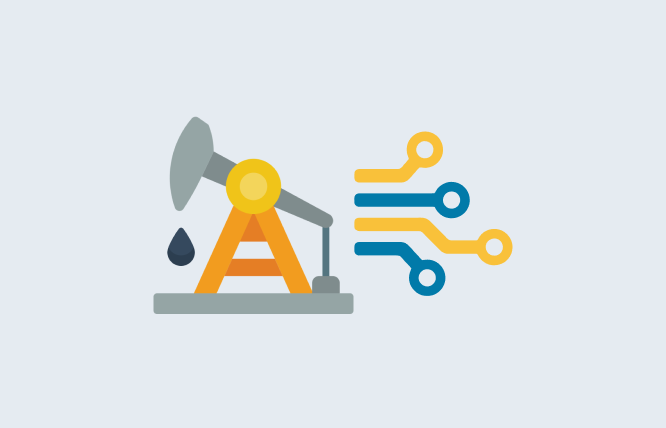Introduction
Digital transformation is reshaping the oil and gas sector, driving efficiency and innovation. This blog explores how technologies like IoT, AI, and Big Data are pivotal in streamlining operations, enhancing safety, and optimising resource management. Key points include:
Businesses all over the world are looking towards digitising their daily operations to help them improve performance and efficiency. The oil and gas sector is no different, with digital transformation playing a huge part in the improvement of the sector. That being said, according to a study by McKinsey, 70% of organisations that have decided to digitise their operations have not gone past the pilot phase.
In this article we will discuss all the challenges about the Digital Transformation in Oil and Gas, as well as the benefits and more.
Challenges of Digitalising the Oil and Gas Sector
While there are a number of contextual reasons as to why the oil and gas sector struggle to get past the pilot phase of their digital transformation projects, there are certain challenges that are often seen as the bottlenecks in these situations. These are as follows:
Updating Legacy Systems
The number one challenge is changing the legacy infrastructure within these organisations. Companies within this sector have been relying on their legacy systems to power their assets for decades. This machinery is now outdated and will not provide the same dynamic results as other cloud-based infrastructure.
The problem lies where the company will need to do a complete overhaul of the system and also train their employees which will naturally have resistance when it comes to learning an entirely new system from scratch.
Cost of Technology
The adoption of digital technologies in the oil and gas sector often requires significant investments in new infrastructure, software, and hardware. These costs can be a barrier for some companies, especially smaller ones or those operating in regions with limited resources.
Additionally, integrating new technologies with existing systems and processes can further escalate costs. Balancing the upfront investment with the expected long-term benefits poses a challenge for many organisations in the industry.
Training and Upskilling
Digital transformation requires a workforce that is proficient in using new technologies and leveraging data-driven insights. However, the oil and gas sector traditionally rely on a workforce with specialised skills in traditional operations.
Upskilling existing employees and hiring new talent with expertise in data analytics, cybersecurity, and other digital domains can be challenging and time-consuming.
Compliance and Security
The oil and gas industry operate in a highly regulated environment with stringent compliance requirements related to safety, environmental protection, and data privacy. As companies digitise their operations and collect vast amounts of data, ensuring compliance with industry regulations and standards becomes increasingly complex.
Data Management
The oil and gas sector generates vast volumes of data from various sources, including exploration, production, refining, and distribution. Effectively managing and extracting value from this data is essential for optimising operations, enhancing decision-making, and driving innovation.
However, many companies struggle with data silos, inconsistent data quality, and legacy systems that hinder data integration and analysis. Developing robust data management strategies, implementing modern data architectures, and leveraging advanced analytics technologies are key priorities for organisations undergoing digital transformation in the industry.
Opportunities of Digital Transformation
While the challenges to implement an organisation-wide digital transformation might be a struggle, the pay off is enough to make the investment. Let’s discuss the benefits that digital transformation can have on the oil and gas sector.
Reduce the Impact of Price Volatility
Digital transformation initiatives enable oil and gas companies to optimise their operations, improve efficiency, and reduce costs, which can help mitigate the impact of price volatility in the industry.
By leveraging advanced analytics, predictive modelling, and real-time data insights, companies can optimise production schedules, streamline supply chain logistics, and optimise asset performance. These capabilities allow organisations to adapt quickly to changing market conditions, optimise resource allocation, and maintain profitability even in periods of fluctuating oil prices.
Support Change Management
Digital transformation initiatives provide oil and gas companies with the tools and technologies needed to facilitate organisational change and drive innovation. By embracing digital technologies, companies can empower employees to work more collaboratively, embrace new ways of working, and drive continuous improvement.
Digital tools such as cloud-based collaboration platforms, mobile apps, and virtual reality training modules can enhance communication, foster knowledge sharing, and facilitate cross-functional collaboration. Additionally, investing in change management programs and providing training and support for employees transitioning to new digital systems and processes can help ensure the success of digital transformation initiatives.
Accelerate Carbon Reduction
Digital transformation plays a crucial role in helping the oil and gas sector accelerate its efforts to reduce carbon emissions and transition to more sustainable energy sources. By digitising operations, optimising energy usage, and implementing advanced monitoring and control systems, companies can identify opportunities to reduce greenhouse gas emissions, minimise environmental impact, and improve overall sustainability performance.
Digital Technologies in Action
The best way to understand the importance of digital transformation is by looking at examples of some of the organisations that have succeeded in going past the pilot project and are reaping the benefits of digital transformation.
Shell has been at the forefront of digital transformation initiatives in the oil and gas industry, implementing a wide range of digital technologies to optimise their operations, improve efficiency, and drive innovation. Here’s how Shell has used digital transformation to enhance its business:
Predictive Maintenance
Shell has deployed IoT sensors and data analytics tools to monitor equipment performance in real-time and predict when maintenance is required. By proactively identifying potential issues and scheduling maintenance activities in advance, Shell has been able to minimise downtime, reduce maintenance costs, and improve asset reliability.
Remote Operations
With remote monitoring and control systems, employees are able to monitor and manage operations from anywhere in the world. This has allowed Shell to optimise staffing levels, improve safety, and respond more quickly to changing conditions, such as weather events or equipment failures.
Digital Twin Technology
Shell has developed digital twin models of its oil and gas facilities, which replicate physical assets in a virtual environment. These digital twins enable Shell to simulate various operating scenarios, optimise performance, and test new technologies before deploying them in the field. By using digital twins, Shell has been able to improve decision-making, optimise production, and reduce risk.
Advanced Analytics
Shell has invested in advanced analytics capabilities to analyse large volumes of data collected from sensors, equipment, and operations. By leveraging AI and machine learning algorithms, Shell can uncover valuable insights, identify trends, and optimise processes to improve efficiency and performance across its operations.
The Digital Twins Concept
In the oil and gas sector, digital twins represent virtual replicas of physical assets, processes, or systems. These twins are created using real-time data collected from sensors, IoT devices, and other sources. The concept aims to provide an accurate, dynamic representation of assets and operations, allowing for simulation, analysis, and optimisation.
Here’s a breakdown of how digital twins work in the oil and gas sector:
Asset Replication
Digital twins replicate physical assets such as drilling rigs, pipelines, refineries, or even entire oil fields in a virtual environment. They capture the geometry, structure, and behaviour of these assets.
Real-Time Data Integration
Data from various sources, including sensors, SCADA systems, historical records, and external sources, are integrated into the digital twin. This data provides insights into asset performance, condition, and operational parameters.
Simulation and Analysis
Digital twins enable engineers and operators to simulate scenarios and analyse performance in a risk-free virtual environment. For example, they can simulate different operating conditions, predict equipment failures, or optimise production processes.
Predictive Maintenance
By analysing real-time and historical data, digital twins can predict equipment failures before they occur. This proactive approach to maintenance helps minimise downtime, reduce maintenance costs, and enhance asset reliability.
Optimisation and Decision-Making
Digital twins facilitate optimisation by providing insights into asset performance and process efficiency. Operators can use this information to make data-driven decisions, optimise production, and improve overall operational efficiency.
Remote Monitoring and Control
Digital twins support remote monitoring and control of assets and processes. Operators can access real-time data, monitor performance, and adjust remotely, reducing the need for physical intervention and enhancing safety.
Securing the Digital Oilfield: Cybersecurity Considerations
As the oil and gas sector embraces digital transformation, cybersecurity becomes a paramount concern due to the increased reliance on interconnected technologies, data-driven processes, and remote access. Here are several key cybersecurity considerations for the industry:
Protecting Critical Infrastructure
Oil and gas facilities, such as refineries, pipelines, and drilling platforms, are critical infrastructure targets for cyberattacks. Ensuring the security of these assets is essential to prevent disruptions to operations and potential environmental or safety hazards.
Securing IoT Devices and Sensors
The proliferation of Internet of Things (IoT) devices and sensors in oil and gas operations introduces new attack surfaces. Securing these devices against unauthorised access, tampering, or exploitation is crucial to prevent data breaches and operational disruptions.
Data Protection and Privacy
With the digitisation of operational data, ensuring the confidentiality, integrity, and availability of sensitive information is paramount. Implementing robust data encryption, access controls, and data loss prevention measures can mitigate the risk of data breaches and protect intellectual property.
Supply Chain Security
The oil and gas sector relies on complex supply chains involving numerous vendors and partners. Strengthening supply chain security through vendor risk management, third-party assessments, and contractual security requirements is essential to prevent supply chain attacks and ensure the integrity of supply chain components.
Industrial Control Systems (ICS) Security
Industrial control systems, such as SCADA and DCS systems, are prime targets for cyberattacks due to their role in controlling critical processes. Implementing measures such as network segmentation, intrusion detection systems, and regular security assessments can enhance the security of these systems and prevent unauthorised access or manipulation.
Employee Awareness and Training
Human error and insider threats pose significant cybersecurity risks in the oil and gas sector. Providing comprehensive cybersecurity awareness training to employees, contractors, and partners can help raise awareness of cybersecurity best practices and reduce the likelihood of phishing attacks, social engineering, or other human-centric threats.
Incident Response and Recovery
Despite best efforts to prevent cyber incidents, organisations must be prepared to detect, respond to, and recover from cybersecurity incidents effectively. Developing and testing incident response plans, establishing clear communication channels, and implementing robust backup and recovery procedures are critical components of cybersecurity resilience.
Regulatory Compliance
The oil and gas sector is subject to various regulatory requirements related to cybersecurity, including industry-specific standards and data protection regulations. Ensuring compliance with relevant regulations, standards, and frameworks, such as NIST, ISO 27001, and IEC 62443, is essential to avoid fines, penalties, and reputational damage.
Conclusion
With the rise in digital transformation all over various industries, oil and gas companies can reap the most benefits from implementing this practice. Here is a quick summary on all the benefits that digital transformation can offer.
| Aspect | Benefits |
| Operational Efficiency | – Enhanced Asset Management: Real-time monitoring, proactive maintenance. |
| Safety and Compliance | – Improved Safety Measures: Monitoring, hazard detection. |
| Cost Reduction | – Optimised Resource Utilisation: Better allocation, reduced expenditures. |
| Environmental Sustainability | – Reduced Carbon Emissions: Energy monitoring, emission reduction. |
| Innovation and Adaptability | – Foster Innovation: Experimentation, collaboration. |
| Stakeholder Engagement | – Enhanced Communication: Transparency, trust-building. |
If you are looking for digital transformation within your organisation, reach out to FuturByte for a free consultation and learn how you can enhance your day-to-day operations.
Frequently Asked Questions
Digital transformation in the oil and gas sector refers to the integration of digital technologies and processes to optimise operations, improve efficiency, and drive innovation across the industry. It involves leveraging technologies such as IoT, AI, cloud computing, and data analytics to streamline workflows, enhance decision-making, and address industry challenges.
The key drivers of digital transformation in the oil and gas sector include the need to increase operational efficiency, reduce costs, improve asset performance and reliability, enhance safety and environmental sustainability, and remain competitive in a rapidly evolving market landscape.
Examples of digital transformation initiatives in the oil and gas sector include the implementation of IoT sensors for remote asset monitoring, the adoption of predictive maintenance solutions, the use of AI and machine learning for reservoir modeling and production optimisation, and the deployment of digital twins for asset simulation and visualisation.
Digital transformation benefits the oil and gas sector by enabling companies to optimise operations, reduce downtime, improve safety and environmental performance, enhance decision-making through data-driven insights, and unlock new revenue streams through innovation and differentiation.
Challenges associated with digital transformation in the oil and gas sector include legacy infrastructure and systems, data management and integration complexities, cybersecurity risks, regulatory compliance requirements, workforce skills gaps, and cultural resistance to change.
Have questions or feedback?
Get in touch with us and we‘l get back to you and help as soon as we can!




